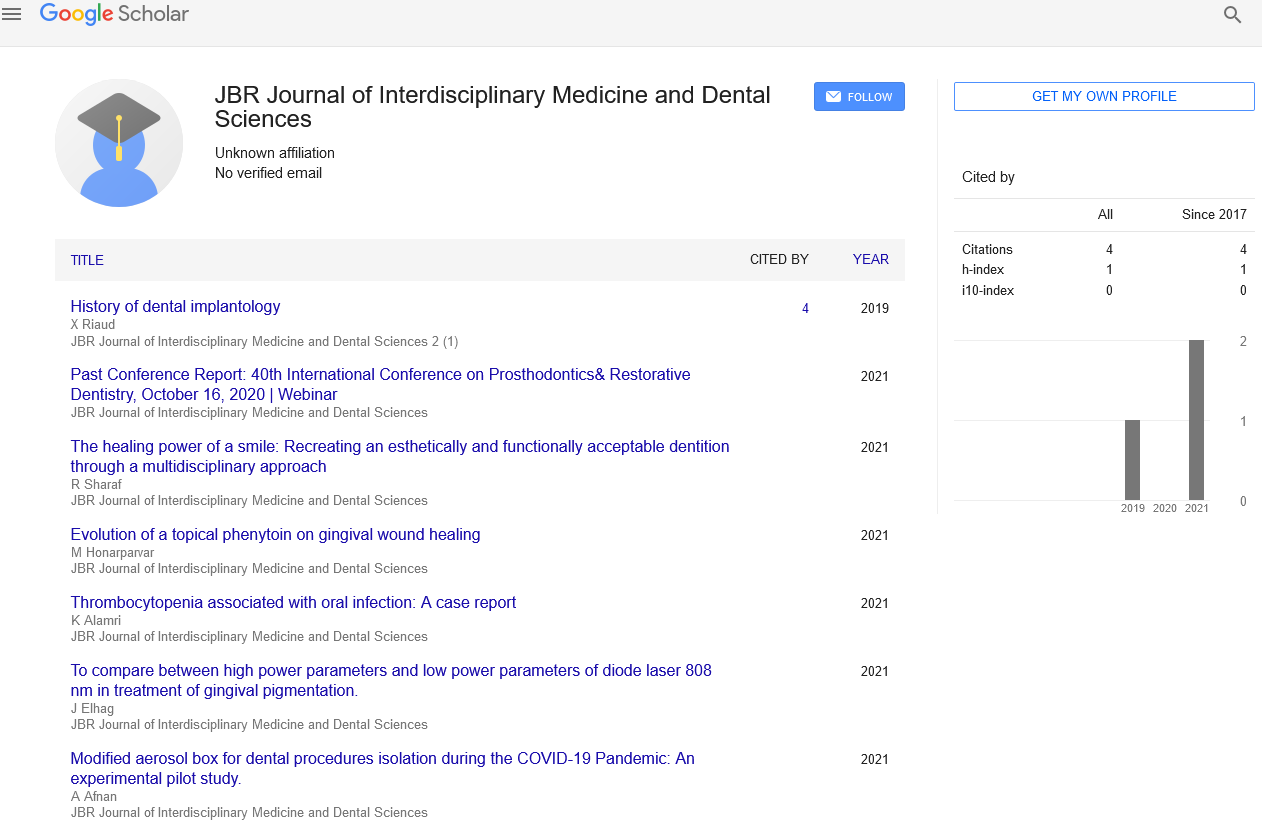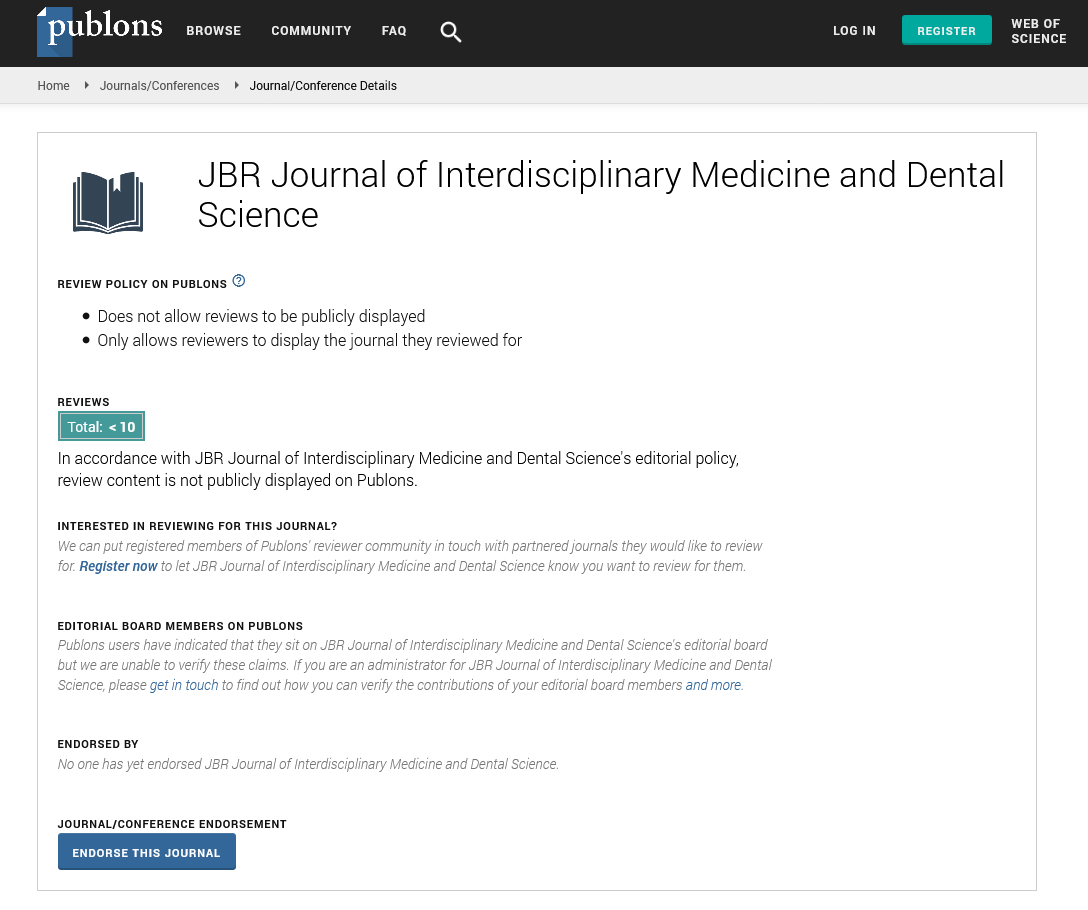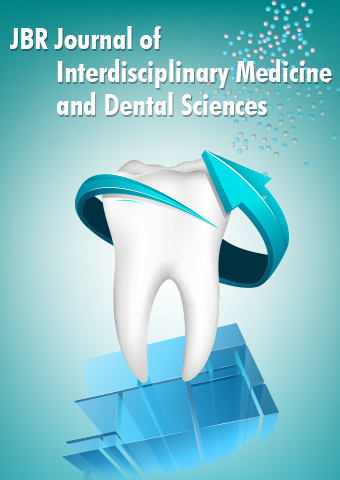Perspective - JBR Journal of Interdisciplinary Medicine and Dental Sciences (2022) Volume 5, Issue 3
A Note on the Calcium Orthophosphate Cements and Concrete
Sergey V. Dorozhkin*
Kudrinskaja sq. 1-155, Moscow 123242, Russia
Kudrinskaja sq. 1-155, Moscow 123242, Russia
E-mail: sedorozhkin@yandex.ru
Received: 02-May-2022, Manuscript No. jimds-22-31004; Editor assigned: 03-May-2022, PreQC No. jimds-22-31004; Reviewed: 16- May-2022, QC No. jimds-22-31004; Revised: 23-May-2022, Manuscript No. jimds-22-31004 (R); Published: 30-May-2022, DOI: 10.37532/2376- 032X.2022.5(3).58-59
Abstract
Researchers discovered self-setting calcium orthophosphate cements, which are a bioactive and biodegradable grafting material in the form of a powder and a liquid. Both phases form after mixing a viscous paste that after being implanted sets and hardens within the body as either a non-stoichiometric calcium deficient hydroxyapatite (CDHA) or brushite, sometimes blended with unreacted particles and other phases. As both CDHA and brushite are remarkably biocompatible and bioresorbable (therefore, in vivo they can be replaced with newly forming bone), calcium orthophosphate cements represent a good correction technique for non-weight-bearing bone fractures or defects and appear to be very promising materials for bone grafting applications [1]. Besides, these cements possess an excellent osteoconductivity, molding capabilities and easy manipulation. The concepts established by calcium orthophosphate cement pioneers in the early 1980s were used as a platform to initiate a new generation of bone substitute materials for commercialization. Since then, advances have been made in the composition, performance and manufacturing; several beneficial formulations have already been introduced as a result.
Keywords
osteoconductivity • non-stoichiometric • craniofacial surgery
Introduction
The first in vivo use of calcium orthophosphates was performed in 1920, when researchers implanted tricalcium phosphate (TCP) into animals to test its efficacy as a bone substitute. In the following years, some other calcium orthophosphates were tested on animals to investigate their effect on the healing of non-union [2]. However, it was 1951, when for the first time hydroxyapatite (HA) was implanted in rats and guinea pigs.
Those attempts might be characterized as the initial medical trials with the first generation of bone substituting biomaterials. However, it was already the 1970s, when other calcium orthophosphates were synthesized, characterized, investigated and tried in medicine. In order to stress the fact that these cements consist either entirely or essentially of calcium orthophosphates, this review is limited to consideration of calcium orthophosphate cements only [3]. Due to a good bioresorbability, calcium orthophosphate cements belong to the second generation of bone substituting biomaterials. These cements are blends of amorphous and/or crystalline calcium orthophosphate powder(s) with an aqueous solution, which might be distilled water, phosphate-buffered saline (PBS), ~ 0.25 M aqueous solution of sodium orthophosphate, orthophosphoric acid, ~ 0.5 M aqueous solution of citric acid or even revised simulated body fluid (rSBF)
Description
The cements provide the surgeons with a unique ability of manufacturing, shaping and implanting the bioactive bone substitute material on a patient-specific base in real time in the surgery room. Implanted bone tissues also take benefits from initial setting characteristics of the cements that give, in an acceptable clinical time, a suitable mechanical strength for a shorter tissue functional recovery [4]. The major advantages of the cements include a fast setting time, excellent moldability, outstanding biocompatibility and easy manipulation; therefore, the cements are more versatile in handling characteristics than prefabricated calcium orthophosphate granules or blocks. Besides, like any other bioceramics, calcium orthophosphate cements provide the opportunity for bone grafting using alloplastic materials, which are unlimited in quantity and provide no risk of infectious diseases. This highly viscous, non-injectable paste can be molded and is therefore used mainly as a contouring material in craniofacial surgery. In the 1990s, it was established that there were about 15 different binary combinations of calcium orthophosphates, which gave pastes upon mixing with water or aqueous solutions, so that the pastes set at room or body temperature into solid cement. It is anticipated that the use of calcium orthophosphate cements will enable a faster and more aggressive rehabilitation, as the strength of the cement makes it possible to allow full weight-bearing earlier than when bone graft is used [5]. Although, preliminary clinical trials have already confirmed the great potential of this novel therapeutic product, calcium orthophosphate cements need to be improved further; in particular, their bioresorption needs to be accelerated as well as their injectability and mechanical properties need to get better.
Acknowledgement
None
Conflict of interest
No conflict of interest
References
- Driessens FCM, Planell JA , Boltong MG et al. Osteotransductive bone cements. Proc. Inst. Mech. Eng. H: J. Eng. Med. 212, 427-435(1998).
- Frankenburg EP, Goldstein SA, Bauer TW et al.. Biomechanical and histological evaluation of a calcium phosphate cement. J. Bone Joint Surg. Am. 80A, 1112-1124(1998).
- Frayssinet P, Gineste L, Conte P et al. Short-term implantation effects of a DCPD-based calcium phosphate cement. Biomaterials. 19, 971-977(1998).
- Combes C, Bareille R., Rey C et al. Calcium carbonate-calcium phosphate mixed cement compositions for bone reconstruction. J. Biomed. Mater. Res. A. 79A, 318-328(1998).
- Fernández E, Planell JA. S.M. Precipitation of carbonated apatite in the cement system 1.α-Ca3(PO4)2 – Ca(H2PO4)2 – CaCO3. J. Biomed. Mater. Res. 47, 466-471(1998).


